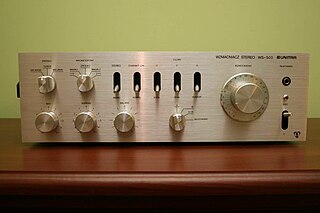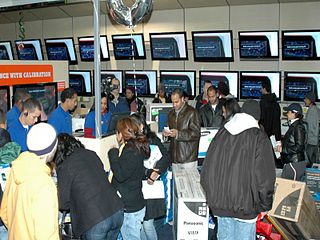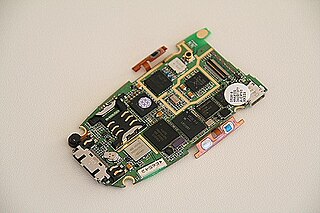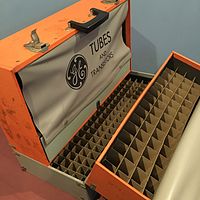
The field of electronics is a branch of physics and electrical engineering that deals with the emission, behaviour and effects of electrons using electronic devices. Electronics uses active devices to control electron flow by amplification and rectification, which distinguishes it from classical electrical engineering, which only uses passive effects such as resistance, capacitance and inductance to control electric current flow.

An amplifier, electronic amplifier or (informally) amp is an electronic device that can increase the power of a signal. It is a two-port electronic circuit that uses electric power from a power supply to increase the amplitude of a signal applied to its input terminals, producing a proportionally greater amplitude signal at its output. The amount of amplification provided by an amplifier is measured by its gain: the ratio of output voltage, current, or power to input. An amplifier is a circuit that has a power gain greater than one.

A vacuum tube, electron tube, valve, or tube, is a device that controls electric current flow in a high vacuum between electrodes to which an electric potential difference has been applied.

Digital electronics is a field of electronics involving the study of digital signals and the engineering of devices that use or produce them. This is in contrast to analog electronics and analog signals.

An audio power amplifier is an electronic amplifier that amplifies low-power electronic audio signals, such as the signal from a radio receiver or an electric guitar pickup, to a level that is high enough for driving loudspeakers or headphones. Audio power amplifiers are found in all manner of sound systems including sound reinforcement, public address, home audio systems and musical instrument amplifiers like guitar amplifiers. It is the final electronic stage in a typical audio playback chain before the signal is sent to the loudspeakers.

Consumer electronics or home electronics are electronic equipment intended for everyday use, typically in private homes. Consumer electronics include devices used for entertainment, communications and recreation. Usually referred to as black goods due to many products being housed in black or dark casings. This term is used to distinguish them from "white goods" which are meant for housekeeping tasks, such as washing machines and refrigerators, although nowadays, these would be considered black goods, some of these being connected to the Internet. In British English, they are often called brown goods by producers and sellers. In the 2010s, this distinction is absent in large big box consumer electronics stores, which sell entertainment, communication and home office devices, light fixtures and appliances, including the bathroom type.
Obsolescence is the process of becoming antiquated, out of date, old-fashioned, no longer in general use, or no longer useful, or the condition of being in such a state. When used in a biological sense, it means imperfect or rudimentary when compared with the corresponding part of other organisms.

A thyratron is a type of gas-filled tube used as a high-power electrical switch and controlled rectifier. Thyratrons can handle much greater currents than similar hard-vacuum tubes. Electron multiplication occurs when the gas becomes ionized, producing a phenomenon known as Townsend discharge. Gases used include mercury vapor, xenon, neon, and hydrogen. Unlike a vacuum tube (valve), a thyratron cannot be used to amplify signals linearly.

Tweezers are small hand tools used for grasping objects too small to be easily handled with the human fingers. Tweezers are thumb-driven forceps most likely derived from tongs used to grab or hold hot objects since the dawn of recorded history. In a scientific or medical context, they are normally referred to as just "forceps", a name that is used together with other grasping surgical instruments that resemble pliers, pincers and scissors-like clamps.

Concealment devices or diversion safes are used to hide things for the purpose of secrecy or security. They are made from an ordinary household object such as a book, a soda can, a candle, a can, or something as small as a coin. The idea is that such an inconspicuous object would not be expected to contain anything of worth.
Lafayette Radio Electronics Corporation was an American radio and electronics manufacturer and retailer from approximately 1931 to 1981, headquartered in Syosset, New York, a Long Island suburb of New York City. The company sold radio sets, Amateur radio (Ham) equipment, citizens band (CB) radios and related communications equipment, electronic components, microphones, public address systems, and tools through their company owned and branded chain of retail outlets and by mail-order.
Futaba Corporation is a Japanese company founded in 1948, originally to produce vacuum tubes. As time passed, production and elemental techniques of the vacuum tube transformed into the manufacturing of vacuum fluorescent displays (VFDs), tool and die set components, radio control equipment and OLED displays.

Rework is the term for the refinishing operation or repair of an electronic printed circuit board (PCB) assembly, usually involving desoldering and re-soldering of surface-mounted electronic components (SMD). Mass processing techniques are not applicable to single device repair or replacement, and specialized manual techniques by expert personnel using appropriate equipment are required to replace defective components; area array packages such as ball grid array (BGA) devices particularly require expertise and appropriate tools. A hot air gun or hot air station is used to heat devices and melt solder, and specialised tools are used to pick up and position often tiny components.

A field-replaceable unit (FRU) is a printed circuit board, part, or assembly that can be quickly and easily removed from a computer or other piece of electronic equipment, and replaced by the user or a technician without having to send the entire product or system to a repair facility. FRUs allow a technician lacking in-depth product knowledge to isolate faults and replace faulty components. The granularity of FRUs in a system impacts total cost of ownership and support, including the costs of stocking spare parts, where spares are deployed to meet repair time goals, how diagnostic tools are designed and implemented, levels of training for field personnel, whether end-users can do their own FRU replacement, etc.

The electronics industry is the economic sector that produces electronic devices. It emerged in the 20th century and is today one of the largest global industries. Contemporary society uses a vast array of electronic devices built-in automated or semi-automated factories operated by the industry. Products are primarily assembled from metal–oxide–semiconductor (MOS) transistors and integrated circuits, the latter principally by photolithography and often on printed circuit boards.

A guitar technician is a member of a music ensemble's road crew who maintains and sets up the musical equipment for one or more guitarists. Depending on the type and size of band, the guitar tech may be responsible for stringing, tuning, and adjusting electric guitars and acoustic guitars, and maintaining and setting up guitar amplifiers and other related electronic equipment such as effect pedals.
Electronic packaging is the design and production of enclosures for electronic devices ranging from individual semiconductor devices up to complete systems such as a mainframe computer. Packaging of an electronic system must consider protection from mechanical damage, cooling, radio frequency noise emission and electrostatic discharge. Product safety standards may dictate particular features of a consumer product, for example, external case temperature or grounding of exposed metal parts. Prototypes and industrial equipment made in small quantities may use standardized commercially available enclosures such as card cages or prefabricated boxes. Mass-market consumer devices may have highly specialized packaging to increase consumer appeal. Electronic packaging is a major discipline within the field of mechanical engineering.

Aviation electronics technician (AT) is a US Navy enlisted rating or job specialty. At the paygrade of E-9, ATs merge with the aviation electrician's mate (AE) rating to become avionics technicians (AV). There has been talk of completely merging the two ratings, but as yet no definite plans have been announced. Aviation electronics technicians wear the specialty mark of a winged helium atom.

In computer hardware, a caddy is a container used to hold some medium, such as a CD-ROM. If the medium is a hard disk drive, the caddy is also referred to as a disk enclosure. Its functionality is similar to that of the 3.5" floppy disk's jacket.

The National Radio Institute-McGraw Hill Continuing Education Center was a private, postsecondary, for-profit correspondence school based in Washington, D.C., from 1914 to 2002. The school originally trained students to become radio operators and technicians.. NRI conducted training courses via mailed lessons, a form of asynchronous learning. NRI's initial home-study course offerings were in radio repair, as well as radio telegraphy & telephony. These courses were designed to be comprehensive, covering all facets of radio technology, including radio operation, broadcasting, manufacturing, sales, and service. An F.C.C. license exam preparation course was implemented and, in time, more courses were added for students to become tradesmen in the broader field of electronic equipment servicing, including TV/VCR repair, basic electronics, automation & control systems, avionic & marine communication systems, and even a very early computer technology course in 1971.. Eventually, NRI implemented courses in electric appliance repair, automotive mechanics, small engine repair, building construction, home inspection, air conditioning, refrigeration, heating & solar technology, computer repair, locksmithing, as well as bookkeeping and accounting. Nevertheless, radio-television electronics remained the company's most prominent division. NRI was America's oldest and largest home-study radio-television-electronics school, a claim that the school frequently advertised. The school was also an accredited member of the National Home Study Council, now known as the Distance Education Accrediting Commission.

















